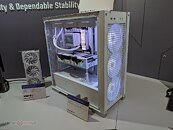- Joined
- Oct 9, 2007
- Messages
- 47,417 (7.51/day)
- Location
- Hyderabad, India
| System Name | RBMK-1000 |
|---|---|
| Processor | AMD Ryzen 7 5700G |
| Motherboard | ASUS ROG Strix B450-E Gaming |
| Cooling | DeepCool Gammax L240 V2 |
| Memory | 2x 8GB G.Skill Sniper X |
| Video Card(s) | Palit GeForce RTX 2080 SUPER GameRock |
| Storage | Western Digital Black NVMe 512GB |
| Display(s) | BenQ 1440p 60 Hz 27-inch |
| Case | Corsair Carbide 100R |
| Audio Device(s) | ASUS SupremeFX S1220A |
| Power Supply | Cooler Master MWE Gold 650W |
| Mouse | ASUS ROG Strix Impact |
| Keyboard | Gamdias Hermes E2 |
| Software | Windows 11 Pro |
The ASUS TUF Gaming BTF cable-free gaming PC build on display at the 2024 International CES really looks like someone either forgot to plug in the cables, or aced at cable management. BTF is an effort to reduce or eliminate most of the visible cables in a gaming PC build, with the aim to improve aesthetics and airflow. BTF isn't some swanky new specification by Intel such as ATX 3.1, it's an ASUS-invented acronym for—we're not kidding—"back to the future." The "back" here refers to the reverse side of the motherboard's PCB, which is where all the connectors and headers actually open out, so you make your connections in the 3-inch wide crawlspace behind the motherboard tray, in an ASUS BTF compatible case. Case compatibility is a must, because the cutouts in the motherboard tray need to align with the connectors.
ASUS goes a step further from similar efforts by companies such as MSI with its Project Zero; by even making its graphics cards cable free. The motherboard has a PCIe power input on the reverse side, which is wired out to a power-delivery slot that connects to second gold finger besides the standard PCI-Express x16; which delivers up to 300 W of power. This brings back memories of EISA addon cards with that VLB extension. The more things change, the more they stay the same. The only thing sticking out in ASUS's build are the coolant tubes of the ROG Ryujin III White AIO cooler. That one can't be avoided.




View at TechPowerUp Main Site
ASUS goes a step further from similar efforts by companies such as MSI with its Project Zero; by even making its graphics cards cable free. The motherboard has a PCIe power input on the reverse side, which is wired out to a power-delivery slot that connects to second gold finger besides the standard PCI-Express x16; which delivers up to 300 W of power. This brings back memories of EISA addon cards with that VLB extension. The more things change, the more they stay the same. The only thing sticking out in ASUS's build are the coolant tubes of the ROG Ryujin III White AIO cooler. That one can't be avoided.




View at TechPowerUp Main Site





 (ok the connector has a different pin layout nonetheless
(ok the connector has a different pin layout nonetheless  )
)